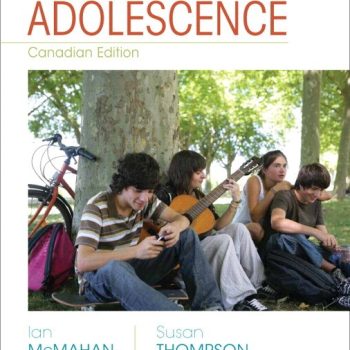Test Bank For Adolescence Canadian 1st Edition By McMahan
Chapter 3: Cognitive Changes Multiple Choice Questions
1) The changes that take place in the ways adolescents think are known as
A) mental progress.
B) informational input.
C) cognitive development
D) knowledge processing.
Answer: C
Page Ref: 76
2) The most important figure to study how children’s thinking changes during development was
A) Sigmund Freud.
B) Jean Piaget.
C) Konrad Lorenz.
D) G, Stanley Hall.
Answer: B
Page Ref: 76
3) For Piaget, the process of trying to understand new information in terms of one’s existing knowledge is known as
A) interaction.
B) maturation.
C) accommodation.
D) assimilation.
Answer: D
Page Ref: 77
4) For Piaget, the process of changing one’s current ways of thinking in response to new experiences is known as
A) assimilation.
B) accommodation.
C) interaction.
D) maturation.
Answer: A
Page Ref: 77
5) According to Piaget, young adolescents enter the stage of _____, in which thinking is based on an abstract system of logic.
A) concrete operations
B) abstract operations
C) formal operations
D) logical operations
Answer: C
Page Ref: 78
6) When trying to understand social relationships in her new school, Farah generates a set of hypotheses about who is friends with whom, then systematically looks for evidence to confirm or disconfirm them. Piaget would place Farah in the _____ stage of cognitive development.
A) sensorimotor
B) preoperational
C) concrete operational
D) formal operational
Answer: D
Page Ref: 78
7) The competence-performance gap is likely to be larger when
A) the adolescent’s attention is divided among different problems.
B) the material fits well with the teen’s own views.
C) the matter is personally relevant.
D) the information being considered is more familiar.
Answer: A
Page Ref: 79
8) Patrick, a 10th grader, does not believe there are such things as UFOs. He is most likely to notice illogical reasoning when reading an article that
A) discusses the benefits and costs of globalization.
B) argues for the existence of UFOs.
C) argues that UFOs are imaginary.
D) explains why 10th graders are superior to younger adolescents.
Answer: B
Page Ref: 79
9) “Cars have four wheels. This object has four wheels, so it’s a car.” This is an example of
A) hypothetico-deductive reasoning.
B) metalogical analysis.
C) inductive reasoning.
D) preoperational thinking.
Answer: C
Page Ref: 79
10) Adolescents are more likely than children to measure their world against abstract concepts such as fairness and justice and to propose ways to improve it, reflecting their greater ability to
A) understand metaphor.
B) use inductive reasoning.
C) think hypothetically.
D) infer conclusions.
Answer: C
Page Ref: 80
11) Adolescents can better grasp sayings such as “When it rains, it pours” through their ability to
A) mentally compare explicit and implicit meanings.
B) understand grammatical rules.
C) ignore abstract relationships.
D) stay focused on concrete aspects of objects.
Answer: A
Page Ref: 81
12) The ability to attend to multiple meanings helps adolescents appreciate
A) concrete information.
B) sarcasm.
C) egocentrism.
D) inductive reasoning.
Answer: B
Page Ref: 81
13) Compared to younger children, adolescents are better at
A) thinking about possibilities.
B) understanding the world in abstract terms.
C) seeing what is as a particular case of what might be.
D) All of the above.
Answer: D
Page Ref: 81
14) The “imaginary audience” is one way that adolescent _____ shows itself.
A) abstraction
B) accommodation
C) egocentrism
D) operationalism
Answer: C
Page Ref: 82
15) As Luigi walks by two girls, one glances at him, then returns to her conversation. He is sure she is making a negative comment about him. Elkind would see this as an example of
A) introspection.
B) the imaginary audience.
C) impression formation.
D) a personal fable.
Answer: B
Page Ref: 82









Reviews
There are no reviews yet.